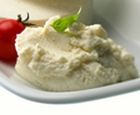|
Mid-East Appetizer Yogurt Cheese This strained yogurt can be used as a tangy, rich spread for pita. You can jazz up the dish by adding dill, diced cucumber, or mint.
Combine yogurt and salt in a bowl. Then scoop yogurt into a large piece of cheesecloth. Make a pouch by tying the corners together. Hang the pouch over a bowl deep enough to ensure the bottom of the pouch doesn't touch the bottom of the bowl.* You want the yogurt to drain its whey. Refrigerate the mixture for 24 hours. After 24 hours, squeeze the pouch to drain the last drops of whey into the bowl. Discard the whey. You now have a thick, creamy spread. Turn the Lebnah into a bowl sprinkle with paprika and parsley. Lebnah is delicious spread on pita and accompanied by a bowl of olives. * One way to do this is to tie the corners of the cheesecloth pouch with a string, then tie string to the center of a long wooden spoon handle. Lay the spoon handle across the rim of a deep bowl and set in refrigerator. Or you can tie the pouch to the wire rack of your refreigerator shelf and place the bowl underneath. |
Tips & Glossary Many of the ingredients used for Middle-Eastern cooking may not be in your spice shelf, but you can find them at Mid-Eastern food stores. So to avoid frustration, make a list of the items you need before trying out the recipes. Toss any old, even unopened, spice jars because they’ve probably lost their distinctive flavors. Put them on your shopping list. Bulgur Wheat: wheat grains that have been par-boiled, dried, and de-branned. Bulgur has a high fiber content and wonderfully nutty flavor. Cardamom: related to ginger. Pods (green, brown, or black) are the best way to store the spice, although high-quality ground is readily available. A equivalency: 10 pods = 1½ tsp. ground cardamom. Coriander: aka cilantro, Chinese, or Mexican parsley. Fresh leaves and dried ground seeds are used in Mid-East, Asian, Indian, and Mexican cuisines. Cumin: related to parsley and carrot plant; an important ingredient in chili powder. Used especially in curries, but also in Mid-Eastern, Mexican and Asian dishes. Cumom has an earthy, peppery flavor. Deep Frying: oil must be hot enough; otherwise food will be soggy and greasy. Use a deep-fry thermometer to ensure proper temperature is reached. When cool, oil can be strained, refrigerated, and re-used. Filo: aka phyllo; paper-thin sheets of raw, unleavened flour dough. Purchase frozen in any grocery store and follow directions on package for thawing. When working with one sheet, keep others covered with a damp towel to prevent drying out. Rosewater: distilled from rose petals and used to flavor Mid-Eastern and Asian cooking. You can make your own—but why? Purchase it at Asian or Middle Eastern food stores. Semolina flour: made from hardy durum wheat. A yellowish flour, it's used in Asian and Mid-East cooking (couscous). In the U.S., it's Farina, a breakfast cereal. Tahini: paste from ground, hulled sesame seeds. A major ingredient in hummus and other Mid-Eastern and Asian foods, you can purchase at most grocery stores.
|
Site by BOOM
![]()
LitLovers © 2024

